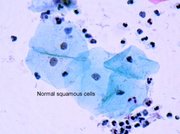Fibrous dysplasia is an idiopathic disorder in which medullary bone is replaced with fibrous and osseous tissue. It is an indolent expansile mass that slowly enlarges until it causes significant clinical symptoms and/or aesthetic deformities. (1) The three clinical forms of this disease are designated type I (monostotic), type II (polyostotic), and type III (disseminated); type III fibrous dysplasia includes McCune-Albright syndrome, which manifests as polyostotic bone changes and is associated with abnormal skin pigmentation, precocious puberty, and endocrine abnormalities.
Only 10 to 15% of monostotic cases involve the head and neck; the most frequently involved sites in this region are the maxilla and mandible. (2) The paranasal sinuses are much less frequently involved, but when they are, the most commonly affected sites are the maxillary and ethmoid sinuses. (3) The author reports a case of fibrous dysplasia involving the ethmoid sinuses.
Case report
A 22-year-old man was referred to the ophthalmology clinic for evaluation of a 1-year history of progressive proptosis of the left eye. The patient expressed no other visual complaints--specifically, no diplopia, eye pain, or blurred vision. Physical examination of the area of gross proptosis revealed that all extraocular movements were normal; no diplopia was elicited. The patient reported no decrease in visual acuity and no compromise of visual fields. Findings oil neurologic examination were entirely within normal limits.
Computed tomography (CT) detected a large lesion that encompassed the area of the left ethmoid sinus and extended into the medial orbital cavity (figure 1). The lesion demonstrated small areas of lucency interspersed among predominantly dense zones of sclerosis. The mass continued to extend superiorly to the skull base of the anterior cranial fossa, and it exerted a mass effect in which it pushed intracranially at its most superior aspect.
[FIGURE 1 OMITTED]
The patient was referred to the otolaryngology clinic, where fiberoptic nasopharyngoscopy did not detect any discrete lesions intranasally or in the middle meatus. T1-weighted, contrast-enhanced magnetic resonance imaging (MRI) found no destructive invasion of the periorbital tissue or of the dura in the anterior cranial fossa (figure 2). It was considered likely that a minimal dural enhancement at the interface of the mass and the dura was attributable to mild edema in this area.
[FIGURE 2 OMITTED]
The patient was taken to the operating room, where the anterior face of the ethmoid bulla was opened endoscopically. A firm, gritty mass was noted to have filled the ethmoid cavity. A biopsy specimen was obtained and sent to pathology, where it was identified as fibrous dysplasia. The lesion was excised by a multidisciplinary team consisting of a neurosurgeon and otolaryngologist. The patient underwent an anterior craniofacial approach for complete resection of the tumor and superior and medial orbital wall reconstruction with titanium mesh. The patient tolerated the procedure well and has since fully recovered without any complications.
Diagnosis and treatment
On CT, fibrous dysplasia of the paranasal sinuses displays a heterogeneous opacification of the sinus cavity, creating the lesion's classic ground-glass appearance. Other features include expansion of the surrounding bone, an intact thin cortex, and no periosteal reaction or cortical breakdown. (3) On T1-weighted MRI, the lesion's signal intensity is intermediate. Administration of gadolinium contrast yields a moderate-to-marked enhancement of the lesion. (3)
Histologically, fibrous dysplasia is characterized by an overgrowth of fibrous stroma over a background of irregularly shaped trabeculae of woven bone in G- and S-shaped configurations.
Surgery is the mainstay of treatment. The extent of surgery is dependent on the patient's symptomatology, the extent of disease, and the degree of cosmetic deformity. Surgical debulking to treat a cosmetic deformity is entirely acceptable for benign cases; symptomatic lesions should be completely excised. (4)
Although the patient in the case described herein complained only of the aesthetic aspect of his proptosis, the lesion's progressive and substantial enlargement over the course of I year and its extension to the anterior skull base led to a recommendation to completely excise the tumor in order to circumvent the likely eventual development of neurologic and ophthalmologic symptoms. Such a recommendation for treatment of fibrous dysplasia of the anterior skull base has been supported in the neurosurgery literature. (5)
References
(1.) Berlucchi M, Salsi D, Farina D, Nicolai P. Endoscopic surgery for fibrous dysplasia of the sinonasal tract in pediatric patients. Int J Pediatr Otorhinolaryngol 2005:69:43-8.
(2.) Kutluhan A, Kiroglu AF, Yurttas V, et al. Monostotic fibrous dysplasia originating from ethmoid bone: Treatment with endoscopic approach. Ann Otol Rhinol Laryngol 2004:113:139-41.
(3.) Mafee MF. Imaging of the nasal cavity and paranasal sinuses. In: Mafee MF, Valvassori GE, Becker M, eds. Imaging of the Head and Neck. 2nd ed. New York: Thieme, 2005:445.
(4.) Ferguson BJ. Fibrous dysplasia of the paranasal sinuses. Am J Otolaryngol 1994:15:227-30.
(5.) Michael CB, Lee AG, Patrinely JR, et al. Visual loss associated with fibrous dysplasia of the anterior skull base. Case report and review of the literature. J Neurosurg 2000:92:350-4.
Edwin K. Chan, MD
From the Department of Otolaryngology--Head and Neck Surgery, New York Eye & Ear Infirmary, New York City, and the Department of Otolaryngology--Head and Neck Surgery, New York Medical College, Valhalla.
COPYRIGHT 2005 Medquest Communications, LLC
COPYRIGHT 2005 Gale Group



